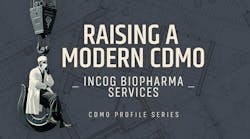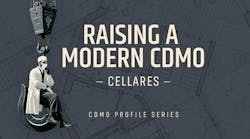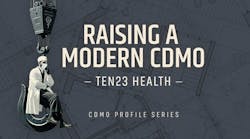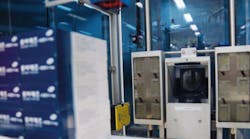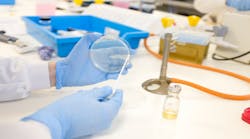Hyaluron contract Manufacturing (HCM) has moved from its roots in viscous filling into areas such as Bubble-free Filling and lyophilization, and was recently selected as a major contributor to Massachusetts’ economic growth. Last year the company expanded its lyophilization capacity and is looking into new ways to approach reconstitution, using commercially available syringes and equipment. CEO Shawn Kinney talks about his company and its new approach to filling, and reconstituting, lyophilized drugs.
PhM: Hyaluron seems an unusual name. Did you start off making hyaluronic acid?
S.K.: I founded the company in 1999, when I planned to develop innovative therapies based on hyaluronic acid, which is used in applications that include tissue healing, eye surgery and treatment for osteoarthritis. At the time, though, the venture capital market was challenging and I saw that it was going to be extremely difficult to launch a new product development company. However, by that point, I had made a number of contacts within the industry who knew I had experience filling syringes with highly viscous liquids, and with hyaluronic acid. They asked if I would consider contract manufacturing hyaluronic acid. I started to do that, and gradually, the company built up a reputation for being able to fill syringes with highly viscous liquids. In 2001, an opportunity presented itself for our company to handle the sterile manufacturing of viscous products. Two years later, we added the capabilities to handle other types of liquids, and we expanded into more traditional filling applications such as vial filling.
Controlling the filling operation is very important, because the choice of stopper, gas bubble size and changes in atmospheric pressure can all contribute to microbiological contamination.
Shortly afterward, some biopharmaceutical companies asked if we could do bubble-free syringe filling with nonviscous liquids. Originally, we may have been a bit overly confident because we thought it would be easy, but discovered just how difficult it can be. We spent the next year and a half developing a Bubble-free Filling technology that would allow us to fill syringes with non-viscous liquids. This technology was patented in 2008.
PhM: What are the technical challenges involved with Bubble-free Filling?
S.K.: The greatest difficulty is ensuring that a reproducible dose is delivered to the syringe. When we’d try to fill under vacuum we’d often get variable filling volume. In some cases, product could also get stuck within the ribs of the stopper.
PhM: So what are the keys to Bubble-free Filling?
S.K.: We learned that we needed to control product temperature and the amount of dissolved gas in the product. We also found that it required some special valving within the liquid path. We worked on this project with Inova Pharma Systems of Germany, which manufactures pharmaceutical filling equipment, but we handled process modifications ourselves.
In 2007, we expanded into lyophilization, initially doing it in standard vials. Early in 2008 we began to demonstrate the feasibility of doing lyophilization in prefilled syringes, especially in dual-chambered prefilled syringes.
PhM: The technology is not commercial yet, but what made you look into this whole area and how are you working out technical hurdles?
S.K.: We were aware of only one contract manufacturing company in the world, Vetter, based in Germany, that produces dualchambered syringes for lyophilized drug product. Diluent is held in the separate chamber. We were intrigued by that approach, and decided to look at doing it ourselves, but we didn’t want to build a proprietary system. We wanted one that would use commercial off-the-shelf technology.
PhM: What was the original response?
S.K.: Almost all syringe manufacturers can make dual-chambered syringes, but they haven’t been selling them because they don’t really have a market. We planned, first, to convince manufacturers to package syringes in a way that would be compatible with standard filling equipment. There wasn’t a market for them. Unable to do this, we decided, instead, to move forward with developing lyophilization in a single-, rather than dual-chambered syringe.
PhM: Have you validated the process yet?
S.K.: We’re completing the process validation, from a microbiological perspective, and hope to complete validation by the third quarter and expect that our work will eventually lead to availability of dual-chambered syringes.
PhM: What are the advantages of using a dual-chambered syringe for lyophilized drugs?
S.K.: Well, let’s look, first, at the advantages of having the drug inside the syringe rather than a vial. If you have lyophilized drug inside a syringe, you can put a needle into it, add diluent and inject directly. There is no over fill needed, as there is with a vial. When a very expensive API or drug is involved, the amount of product lost to over fill can be significant. So it would offer a cost savings there. But the advantages also come at the point of use. When someone administers a lyophilized drug, you’re counting on them to reconstitute the product correctly, and then move the correct amount of material into the syringe. Pre-filled syringes eliminate any concerns about medical error, and improve both the reproducibility and precision of the delivered dose.
PhM: How about the devices available to help reconstitute freeze-dried drugs?
S.K.: Devices such as Duoject’s Smart-Rod and West’s Clip’n’Ject make it easy to connect a pre-filled syringe and vial, and transfer the liquid between them. Most of them were designed to reconstitute a lyophilized product in a vial, with the diluent in the syringe. Once you’re finished reconstituting, you pull the drug product out of the vial and into the same syringe. However, the devices can also be used in the opposite way, with the drug product inside the syringe and the diluent within the vial. Essentially, they create a dual chamber device.
PhM: Would you plan to license this technology?
S.K.: A lot of what we’re developing around lyophilization and pre-filled syringes involves technologies that are not proprietary, but readily available on the market.
We’re using commercially available syringes, filling and lyophilization equipment, but making minor equipment modifications. That would be part of the attraction . . .users would not be limited to a proprietary technology owned by just one company. Clients would have to study stability and reconstitution. We aren’t working with any company
on any particular product and won’t until validation is complete, but we’ve seen a lot of interest, particularly from biopharmaceutical companies.
